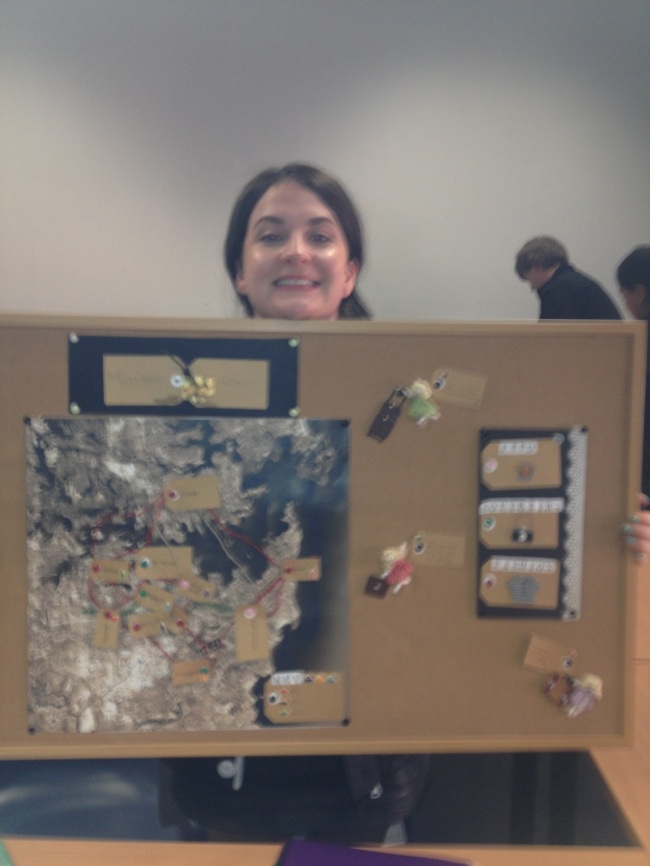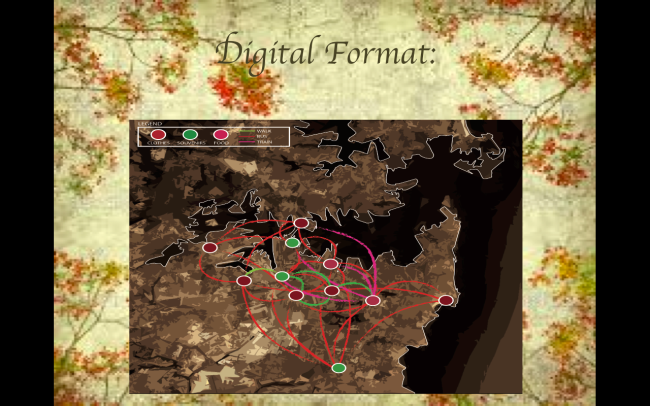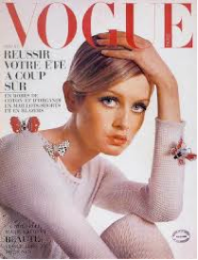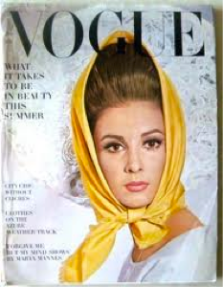Question: But what’s happening today-the mass ability to communicate with each other, without having to go through a traditional intermediary- is truly transformative.
For an extended period of time the world of media has been disrupted and reconstructed through the force of the Internet. There is no longer a traditional intermediary, creating a wide spectrum of publishing power, breaking down the force of control. This is transforming society in terms of reach. Here, the fashion magazine industry is struggling to survive due to the advance of the sphere of fashion bloggers, the every day person inviting the wider public into their personal space, breaking down spatial and temporal boundaries and reconfiguring traditional notions of publishing. Here, the hierarchy of publishing is changing. These bloggers are becoming empowered social bodies, looked up to by the public. This breakaway is transformative in its communicative and connective abilities. Bloggers have the upper hand due to their assemblage of fashion marketing and journalism in terms of written and visual work. This has affected the publishing world, both positive and negative.
“The mass ability to communicate with each other, without having to go through a traditional intermediary- is truly transformative.” (Rusbridger. A. 2010.) There is no longer the middle- man or the Fourth Estate selecting or declining information. Everyone and anyone have the power to publish if they have Internet access, changing the hierarchy of publishing. It is not about having status, but rather a platform to communicate. In terms of fashion blogs, there are numerous platforms including; Instagram, Twitter, Facebook, Tumblr, WordPress, available to anyone for publishing. Unlike traditional media “the online world has no center, no gatekeeper, no margins,” (Errington. W, Miragliotta. N. 2012. Pg. 58.), therefore an ability to maintain and restrain information, as presented through the role of the fourth estate, is almost impossible. There is no person standing as an authoritative power figure determining what information should be presented to the public like that of a fashion magazine editor. Traditional fashion publications such as Vogue, have stood for several decades as trend setters. However, today, with the ability for anyone to present ideas of fashion, there is no specific talking point, as previously presented. The ability to comment on blogs provides strong engagements and an empowered voice for society through the conversational platforms. “Readers become writers, communication flowing both ways.” (Glaysher. F. 2010.) Further, bloggers invite audiences into their personal world, creating human interest and potential loyalty. This is negative for traditional publications, declining their brand loyalty, which in turn is declining revenue.
In order to understand the reach possibilities of fashion blogs, social fashion influencer, the Digitallux, segmented fashion publication users across 31 countries, with an analysis of over 550 blogs. (Visual.ly. 2011.) Here the invisible became visible, through researching specific blogs and how they are structured across the globe, providing society with an idea of the nature of the blogosphere. They researched four different fashion blog sectors within each country; editorial, street style, Do It Yourself (DIY), and personal style. For the purpose of this essay two countries will be examined; North America and Australia. Within North America 304 blogs were examined. The results found; 21% were DIY, 33% personal style, 7% street, and 38% editorial. In terms of Australia, 25 blogs were researched with; 20% DIY, 12% street style, 24% personal style, 44% editorial. The variety of blogs enables the blogosphere to cater to a variety of interests regardless of space or time, a truly transformative ability. In North America, 83% of blogs were on twitter and 46% on Facebook. In Australia, 80% are on Twitter and 36% on Facebook. Their positioning on social media sites allows for the blogs to be easily shared, reached and connected to, something that traditional publications cannot necessarily provide. Traditional publications, are attempting to keep up, representative in their online publications.
The numerous platforms allows for individuals to seek out other blogs that connect to their interests, enabling them to create their own archive of information. There is an “always on culture” (Errington. W, Miragliotta. N. 2012. Pg. 11.), therefore, people are constantly seeking out new information. To view the visualization visit: http://visual.ly/global-fashion-blog-stats.
The Internet is creating freedoms of all sorts in terms of information retrieval and creation. “Its not a digital trend. It’s a trend about how people are expressing themselves.” (Rusbriger. A. 2010.) People want to feel empowered, and are becoming empowered. In terms of the online fashion arena, people desire to create their own archive of images and information. One blogger said; ‘the Internet has empowered me. I am no longer tied to what the fashion magazines want to show me. I can go out and find it myself without even leaving my home, and I thank the fashion bloggers for that.” (Fonseca. H. 2013.)
Numerous bloggers provide a variety of styling information, imagery and ideas that constantly develop. These bloggers are expressing themselves through a platform, and providing the audience with their own platform of expression and connectivity with others with similar interests, creating a community. Bloggers such as Tuula and the counterpart Tuula Vintage take audiences on a fashion journey around the world, giving them a detailed insight into the world of fashion. Here the blogger is personalized, and therefore receives loyalty due to his or her presence as a social body.
The restrictions on how to publish and reasons to publish have been broken down. The Guardian Editor in Chief said; “(its) about a new democracy of ideas and information…about the releasing of individual creativity.” (Busfied. S. 2010.) It’s interesting in that everyone has the ability to publish materials, regardless of their degree, social standing, opinion, etc. For a fashion blogger to be heard there is no need to present their work to a traditional publisher. In actuality, there is probably more chance of being approached by a publisher. Here both the creator and the recipient are empowered in their ability to communicate and share. Here, traditional journalism is under attack, fighting for survival. Further, the quality, reliability and affect of the published work are questioned with the removal of an intermediary, a watch- dog. This is potentially problematic. There is a gradual movement from “a distinct genre of journalism; as a vital means of accountability, almost the fourth estate itself; and the first draft of legislation.” (Errington. W, Miragliotta. N. 2012. Pg. 182. ) In this it is difficult to monitor information.
There is a wider spectrum of information published. Numerous bloggers converge film, photography, written work etc., creating an edge that a traditional publication lacks. “Convergence has increased the potential reach.” (Jenkins. 2006. 14), Connecting to a wider variety of interests. Fashion publications are realizing this threat and therefore have started using these tools on their online publications. Publications such as Teen Vogue have worked with bloggers, understanding their influence on society and their techno-savvy nature. Reinforcing the idea of archive fever in what Derrida explains; different media constitutes different ways of thinking. Individuals and institutions are their archives (Derrida. Howard. S. 2007.) “It’s not that publishers aren’t adapting—its their tool belts that aren’t evolved enough to meet most acute needs.” (Sachir Kamdar, Media Shifts. 2012.) The Internet allows you to archive information easily. Instantaneously there is a date and time published with a post, stored within the blog. This is important for both the blogger and the consumer in their ability to revisit the post. They post blogs daily or weekly, making them easily researched and therefore easy to follow and share.
Traditionally, publishing was a process with different people having different set roles. In traditional magazine publications there is a process of writing, presenting to the editor for publishing approval, printing, assembling the actual publication as a whole and then selling to the public. People were delegated roles, enabling a smooth running process as explored through the notion of a commons space. “A commons arises whenever a given community decides that it wishes to manage a resource in a collective manner, with a special regard for equitable access, use and sustainability.” (Bollier. D. 2010.) Today, however, its one person typing and clicking the “post” button. Traditionally, The material and those who published held exclusive positions, due to its general ability to influence and shape the nature of both society and culture. This hierarchy is changing.
The role of these new publishing bodies is not so simple. There is imbedded an assemblage of marketer, stylist, journalist, model, editor, photographer, publisher, etc. “Individuals are self selecting… with diverse capabilities and interests.” (Errington. W, Miragliotta. N. 2012. Pg. 41.) This shows a shift in consumer behavior and attitudes. “Brands have figured out by now that fashion bloggers have real influence- and that street blogs can really drive people to buy their clothes.” (Wilkinson. I. The daily Beast. 2013.) Designers use bloggers as chief marketers and advertisers for their latest product or fashion line. This is two fold in that audiences will become exposed to both parties. People are now truly becoming connected to the fashion world, specifically when bloggers attend fashion shows and high- end events.
Traditional intermediaries “find it difficult to look outside the frame of their own medium and look at what this animal called social, or open media does.” (Glaysher. F. 2010.) They need to understand that bloggers are moving at the same speed as society and the happenings within. “We are travelling through a period of extreme change faster than our corporate bodies can cope with.”(Rusbridger. A. 2010. The Guardian.) For instance, bloggers are meeting societies desires for instant, personalized information in their constant postings and talking points. Further, bloggers are providing free and easily accessible information. The movement could be seen as a problem in the disconnection from traditional notions of space and time. Society may lose nostalgia as presented through a traditional publication.
On another level, “blogs are great communications tools, search engines (and advertisers) love their constant supply of fresh content and they allow readers and authors to interact more directly than ever before.” (Goudie. E. Helium. 2009) The blogger does not need to pay anyone for his or her services as they have taken on almost all roles; therefore there is no definite profit to be made to make up for pay –checks, therefore the consumer does not pay. Unlike bloggers, magazines need to pay models, photographers etc. The issue of payment and the easily accessible nature of the blogging world are changing the hierarchy of publishing. Although the free nature of the blog is seen as positive, they are breaking down the structure of a commons space where each person has a specific role in order to keep society running. This can be fatal in that there will be job losses and instability within society. Further, the notion of the business model is becoming in jeopardy. Although they are making revenue from advertisements, they still need to charge for the publications to cover the costs. Should they charge though?
With the ease of becoming a publisher on the Internet, there is becoming a crowded market of information. An overcrowded market means lack of attention. “Attention has its own behavior, own dynamics, own consequences.” (Goldhaber. M. H. Wired. 1997.) In the overcrowded market people are not attentive to one specific blog or publication in their ease to connect to numerous sites at once. Therefore, the blogger needs to present something exciting, inviting and new. There is needed “a true market place of ideas flourish and compete for the reader.” (Glaysher. F. 2010.) The traditional structure of the industry is diminishing. A major problem is that “anyone can become a blogger, and anyone can use a blog to spread any sort of information, true or untrue.” (Goudie. E. Helium. 2009.) With a lack of attention, people will consume and believe almost anything; therefore, the nature of today’s publishing structures can be problematic. Without a middleman, it is hard to trust the information and its potential affects on both society and individuals.
It is evident that the online world, including the positioning of fashion bloggers has little to no intermediaries in guiding and controlling information. This is both positive and negative. On one hand, the freedom to publish is enabling society to become further connected. Further, the ability to source and create information is providing individuals with the power to connect to their own specific interests that are not constructed by authoritative figures. However, on the other hand, without intermediaries, potentially damaging information can be presented to society, and further, numerous jobs may be lost.
References:
- Busfield. S. 2010. Guardian Editor Hits Back At Paywalls. The Guardian UK. Accessed 8 June 2013. http://www.guardian.co.uk/media/2010/jan/25/guardian-editor-paywalls
- Bollier. D. 2010. Imagining A New Politics Of The Commons: A Fresh Way Of Thinking Of Life Beyond The Market. Guernica. Accessed 8 June 2013. http://www.guernicamag.com/daily/david_bollier_imagining_a_new/
- Derrida. Howard. S. 2007. Reposted” Archive Fever: A Dusty Digression. Early Modern Notes. Accessed 6 June 2013. http://earlymodernnotes.wordpress.com/2007/09/25/reposted-archive-fever-a-dusty-digression/
- Errington. W, Mirgliotta. N. 2012. Media and politics an introduction. Second edition. Oxford University Press, Melbourne. Pgs. 11- 58.
- Fanesca. H. 2013. What’s Wrong With Fashion Blogs? The Style Confessions. http://thestyleconfessions.com/2013/03/11/whats-wrong-with-fashion-blogs/
- Fonseca. H. 2013. The Style Confessions. Accessed 9 June 2013. http://thestyleconfessions.com/2013/03/11/whats-wrong-with-fashion-blogs/
- Glaysher. F. 2010. Literary Writers In A Post- Gutenberg Age Of Self-Archiving and Self Publishing. Fglasher. Accessed 8 June 2013. http://www.fglaysher.com/Post_Gutenberg_Publishing.html
- Goldhaber. M. H. 1997. Attention Shoppers. The Wired. Accessed 6 June 2013. http://www.wired.com/wired/archive/5.12/es_attention.html
- Goudie. E. 2009. The Negative side of Blogging. Hellium. Accessed June 5 2013. http://www.helium.com/items/1574407-the-negative-side-of-blogging
- Jenkins, H. (2006) “Buying into American Idol: How We Are Being Sold On Reality Television” In Convergence Culture: Where Old and New Media Collide. New York: NYU Press, pg. 14.
- Kamdar. S. 2012. Why Publishers are About To Go Data Crazy. Media Shift. Accessed 6 June 2013. http://www.pbs.org/mediashift/2012/01/why-publishers-are-about-to-go-data-crazy017
- Rusbridger. A. 2010. The Splintering of The Fourth Estate. The Guardian UK. Accessed 8 June 2013. http://www.guardian.co.uk/commentisfree/2010/nov/19/open-collaborative-future-journalism
- Rusbriger. A. 2010. The Splintering of The Fourth Estate. The Guardian UK. Accessed9June2013. http://www.guardian.co.uk/commentisfree/2010/nov/19/open-collaborative-future-journalism
- [1] Rusbriger. A. 2010. The Guardian UK. Accessed 8 June 2013. http://www.guardian.co.uk/media/2010/jan/25/guardian-editor-paywalls
- Visual.ly. 2011. Global Fashion Blog Stats. Accessed 10 June 2013. http://visual.ly/global-fashion-blog-stats
- Wilkinson. I. 2013. Have Fashion Bloggers Gone Too Far? The Daily Beast. Australia. Accessed June 8 2013. http://www.thedailybeast.com/articles/2013/02/18/have-fashion-bloggers-gone-too-far-suzy-menkes-vs-leandra-medine.html





